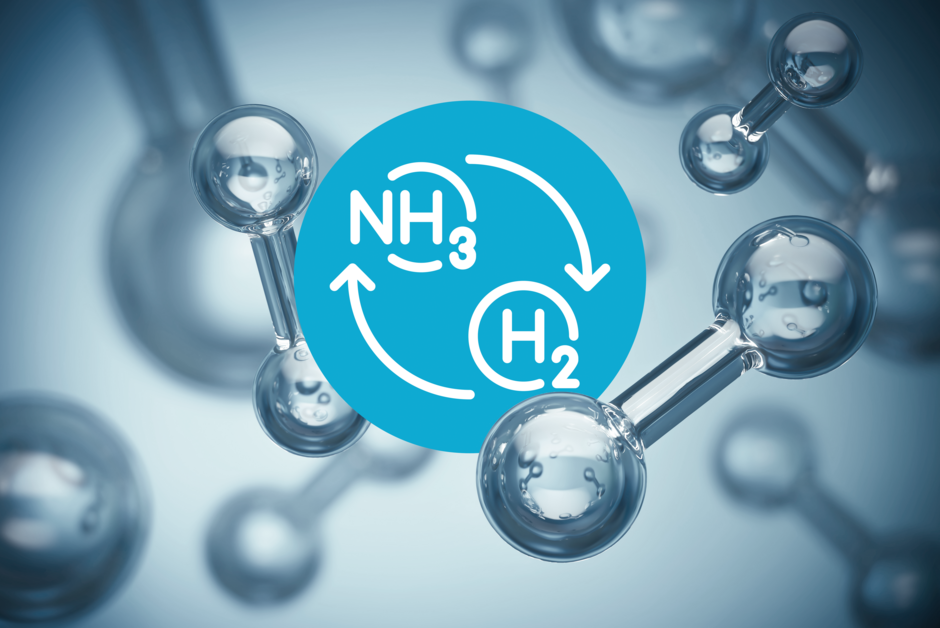Innovation area II
Direct use
This innovation area investigates the direct utilization of chemically bound energy in ammonia for various applications. Research topics include the ignition and combustion properties of ammonia and its direct use in fuel cells.

Sub-project II.1
Experimental analysis of ammonia-hydrogen combustion
The problem with the combustion of ammonia is its inertness. Therefore, an interesting approach is the preliminary partial conversion of ammonia to hydrogen, so that a suitable reactivity is achieved by mixing NH3 with small amounts of H2. This results in research questions concerning the combustion properties of NH3 as a function of the H2 content, laminar and turbulent burning velocity, flame stability limits and pollutant emissions under different pressures.
Researchers
Prof. Dr. Friedrich Dinkelacker
Leibniz University Hannover
Sub-project II.2
Reaction kinetics and emissions of ammonia-hydrogen combustion and ammonia synthesis
The direct use of ammonia in energy and transport systems is challenging due to the difficult combustion behavior as well as emissions of nitrogen oxides (NOx, N2O) and unburned ammonia. A promising solution to these problems is the preliminary partial cracking of ammonia. In order to gain a better understanding of the combustion properties of these cracked ammonia mixtures and “impure” ammonia, including the flame behavior and external ignition as well as the emission profiles, this project will comprehensively investigate the reaction kinetics of the fuels, both experimentally and theoretically.
Researchers
Prof. Dr. Ravi Fernandes
Physikalisch-Technische Bundesanstalt (PTB)
Sub-project II.3
Numerical investigation of ammonia-hydrogen combustion
The project will develop numerical simulation methods for ammonia-hydrogen combustion using a CFD solver. New kinetic reaction mechanisms to describe the flame stability and the formation of pollutants, especially NOx, N2O and unburned ammonia, are needed to facilitate predictive and computationally feasible simulations. The data on the reactivity of the NH3 mixture with partially released H2 and the flame ignition will be used to determine the relevant operating conditions. The simulations are validated against experimental data for a range of different mixtures, from 100% H2 to 100% NH3.
Researchers
Prof. Dr.-Ing. Federica Ferraro
TU Braunschweig
Sub-project II.4
New types of catalyst layers for the low-temperature direct ammonia fuel cell
This project aims to synthesize novel types of electrocatalysts free of precious metals for use in low-temperature direct ammonia fuel cells for the ammonia oxidation reaction (AOR). As possible material classes for the electrocatalysts, transition metals on carbon and metal-nitrogen-carbons (M-N-C catalysts) will be selected and investigated.
Researchers
Dr. Corinna Harms
German Aerospace Center (DLR) - Institute of Engineering Thermodynamics
Sub-project II.5
Flexible H₂ recovery/conversion of ammonia into electricity in high-temperature direct ammonia fuel cells
Integrating the endothermic reaction for the conversion of NH3 in oxide ceramic high-temperature fuel cells (HT-DAFC) for direct electrochemical utilization requires a reliable prediction of the temperature profile and the reaction current density along the flow field. Based on an existing model for fuels used so far (hydrogen, methane, methanol), the project aims for a two-plus-one-dimensional modeling of a solid oxide fuel cell directly supplied with NH3.
Researchers
Prof. Dr.-Ing. Stephan Kabelac
Leibniz University Hannover
Sub-project II.6
Mechanistic analyses of the low-temperature direct ammonia fuel cell at cell level
In this project, diagnostic investigation methods are applied to the low-temperature direct ammonia fuel cell (DAFC). The aim is to determine the individual contributions of the overvoltages due to the kinetics (in particular the ammonia oxidation reaction, AOR) as well as the charge and electron transport processes at cell level. A better understanding of the processes in the cell and at the electrode-electrolyte interface will enable a long-term improvement in the power densities of LT-DAFCs.
Researchers
Prof. Dr. Mehtap Özaslan
University of Hamburg
Sub-project II.7
Innovative thin-film catalyst layers for ammonia as a fuel in low-temperature DAFCs
The objective of this project is to identify and implement innovative thin-film catalysts for the low-temperature DAFC. For this purpose, catalyst layers are applied directly by magnetron sputtering to a gas diffusion layer for the production of a gas diffusion electrode (GDE) in order to realize very low and efficiently used catalyst loadings. The focus will be on the ammonia oxidation reaction (AOR), for which common precious metal thin-film catalyst materials will initially be produced and characterized from a materials science and electrochemical perspective.
Researchers
Dr. Dominic Walter
Institute for Solar Energy Research in Hamelin (ISFH)